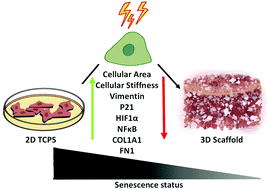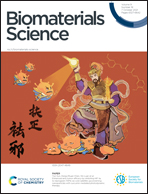Senescent cells in 3D culture show suppressed senescence signatures†
Abstract
Cellular senescence, an irreversible proliferation arrested but viable cellular state, has been implicated in the progression of several age-associated pathologies. A vast amount of information about senescence has been acquired in cultured cells; however, senescence in living organisms (in vivo) remains poorly understood, mainly because of technical limitations. Furthermore, it is now widely recognized that three-dimensional (3D) culture systems are a better mimic of the in vivo physiology. Herein, senescence was induced in HeLa cells by irradiation. Non-senescent or senescent cells were cultured in soft 3D polymer scaffolds and compared with cells in conventional two-dimensional (2D) culture. This work shows that the morphology of the senescent cells markedly varies between substrates/culture platforms, driving the differences in the cytoskeletal organization, cellular division, and nanomechanical properties. One characteristic feature of senescent cells on 2D culture systems is the enlarged and flattened morphology; however, such drastic changes are not seen in vivo. This is an artificial effect of the substrate, which renders such non-physiological morphology to senescent cells. In the 3D scaffolds, this artifact is reduced. Hence, it serves as a better mimic of tissues, leading to reduced expression of senescence-associated genes, implying that the 3D scaffolds suppress the senescence in cells.



 Please wait while we load your content...
Please wait while we load your content...